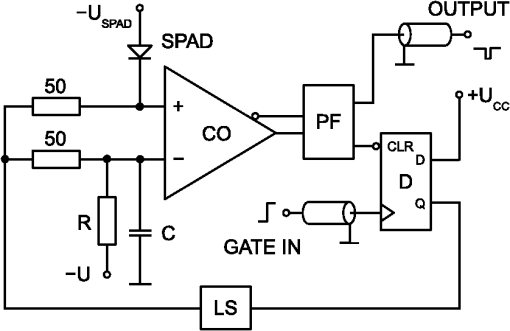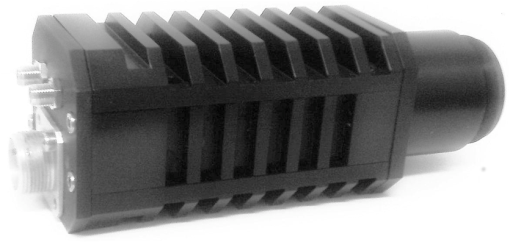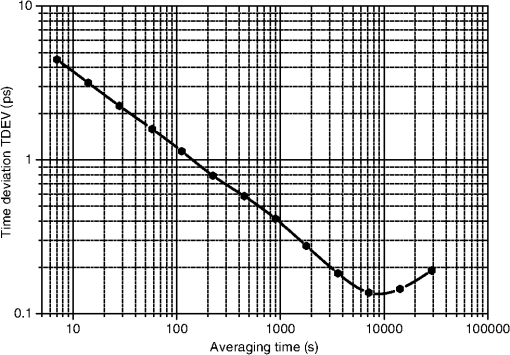|
|
1.IntroductionThe two-way time transfer is an effective way to synchronize two independent time scales with high precision and accuracy independently on the variations of the interconnecting channel.1 In our previous work, we have demonstrated electronic circuits for two-way time transfer via a single coaxial cable with picosecond accuracy and precision.2 The two-way time transfer principle2 implicates higher repetition rate of operation to effectively monitor the changes of the interconnecting channel. The experiment proved the capability of two-way time transfer technique to maintain picosecond stability over the periods of seconds to days. The systematic errors on the order of units of picoseconds have been achieved.3 For distances longer than a few kilometers, the optical approach may be considered. The photon counting approach to the signal detection provides several additional key advantages: the reduction of most systematic errors found in commonly used multiphoton detection systems and the capability to operate with ultimately low signals. However, single photon counting detector operation at high repetition rate decreases its temporal resolution. The new operation scheme described in this paper allows us to convert the detector stability into effective high-repetition-rate single photon counting. The repetitive optical signals of an average intensity as low as photon/pulse may be detected and time tagged with subpicosecond precision and stability. We have designed and tested the optical analogy of the two-way time transfer using a common optical channel. Our group is also involved in several optical one-way time transfer experiments,4,5 where requirements on the detector are different, due to the low repetition rate of the entire experiment and the assumption that optical path is almost unvarying. 2.Detector ConstructionThe detector is based on the single photon avalanche diode (SPAD) chip. The detection chip was manufactured using the K14 technology.6 The K14 SPADs have these basic parameters: active area diameter of 25 to 200 μm breakdown voltage of 29 V, timing resolution better than 20 ps rms, and an acceptable dark count rate. Optional thermoelectrical cooling of the chip may be used to reduce the detector effective dark count rate. Typically, the 200-μm diameter detection chips are housed in a vacuum housing and cooled down to . Cooling the detection chip down to this temperature is resulting in a reduction of an effective dark count rate by three orders of magnitude. The SPAD detection chip is operated in an active quenching and gating (AQG) circuit, its block scheme is shown in Fig. 1. The SPAD detection chip avalanche current buildup is sensed by the comparator (CO), its complementary outputs are formed and level shifted in a pulse forming (PF) circuit. The gating logic is controlled by the flip-flop bistable circuit type D (). The logical circuit output is level shifted (LS) to provide the bias control of the SPAD sensor. The detector is activated by the leading edge of the gate signal, and it is deactivated by breakdown occurrence. The avalanche current is quenched as soon as an avalanche buildup is sensed. Then the detector remains deactivated until the next gate signal is received. The comparator CO trigger threshold is fine-tuned by a resistor , and the SPAD capacitance is compensated by a capacitor . The circuit is constructed on a multiple-layer printed circuit board of . The matched microstrip lines are used for all signal lines; the comparator and pulse forming circuits are based on broadband (6 GHz) components to ensure low timing jitter and good delay stability. The output signal is generated in a form of a uniform negative pulse with the amplitude of and fall times . The circuit total power consumption is 1 W. The temperature sensor is installed close to the comparator to enable the device temperature monitoring. The thermoelectrically cooled detection chip with its AQG circuit in ground segment version is built in a housing of with focusing optics, see Fig. 2. The AQG circuit enables us to operate the SPAD chip of 0.5 up to 4 V above its breakdown voltage. The bias above breakdown in a range of 1.8 to 2.2 V is a frequently selected trade-off between dark count rate, detection probability, and timing resolution. 3.Detector Tests and ResultsThe detector package based on a thermoelectrically cooled SPAD chip having an active area diameter of 200 μm has been used. The SPAD bias was set to 2.0 V above its breakdown voltage. The resulting detector characteristics are as follows. The effective dark count rate was typically 8000 cps. The photon detection efficiency was estimated on the basis of two measurements: first the responsivity in of the detection chip was measured for a wavelength range of 500 to 1100 nm. The photon detection probability (PDP) was measured to exceed 40% at 532-nm wavelength.7 The PDP curve has been plotted on a basis of these two measurements in Fig. 3. Note that PDP exceeds 40% in a wavelength range spanning from 500 to 800 nm. Fig. 3Single photon avalanche diode (SPAD) detector package photon detection efficiency, SPAD biased 4 V above its breakdown voltage. 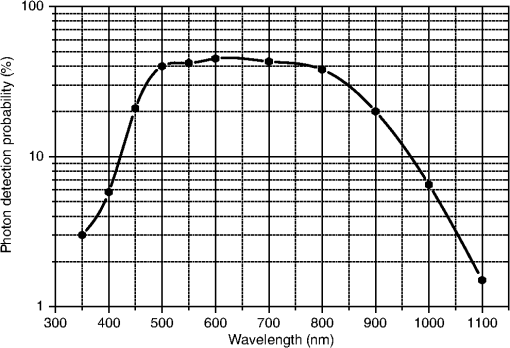 The timing characteristic of the detector package was tested in a series of time-correlated photon counting experiments. The picosecond optical pulses were generated using a PicoQuant diode laser which provided optical pulses 90-ps long at a wavelength of 531 nm. The laser was externally triggered at the repetition rate of 10 MHz synchronously to the local time base. The time base was provided by TM-4 GPS timing system. This setup provides an exceptionally low timing jitter of the optical output with respect to a local time scale. This jitter is of the order of 10 ps. The local time scale consists of a 10 MHz clock reference and 1 pps timing pulse. The epochs of the detector output signals were determined using the new picoseconds event timer system built by our group.8 It provides subpicosecond timing resolution and stability of several femtoseconds.9 These figures enable us to characterize the timing properties of the photon counting detectors on a subpicosecond level. The overall timing jitter of the setup was 50 ps rms. Considering the contribution of the remaining parts of the measurement chain, a detection jitter of the photon counting detector of 19 ps was determined. The long-term stability of the detection delay was tested in a similar experiment, which lasted a weekend. The temperature was stable up to within this experiment. In Fig. 4, the precision in the sense of time deviation10 is plotted. The time deviation values lower than 200 fs for averaging times of hours may be seen. The dependence of the detection delay on temperature was tested in a similar experiment. The detector package under test was heated by means of a hot air gun. Simultaneously, the built-in temperature sensor was used to monitor the actual temperature of the device. The determined slope is . 4.Operational Scheme that Enables Us to Achieve Very High Useful Data YieldsThe timing system employed in our experiments is able to acquire the data at the rate of maximum.8 This value is rather low for a foreseen application—photon counting. Considering the nature of photon counting experiments, usually much higher data acquisition rates are needed. That is why a new experiment setup together with a new technique of data acquisition and processing has been developed and tested. The new setup is based on the fact that the laser signal source may be operated in much higher repetition rate (10 MHz) and may be operated synchronously to the local time scale with high precision. The photon counting experimental data are processed as modulo period of the laser source (100 ns in our case). The example of the raw photon counting data is plotted in Fig. 5. Fig. 5Histogram sample of measured photon counting data. The time is plotted relatively to gate signal event. In inset figure is the superposition of all individual responses. 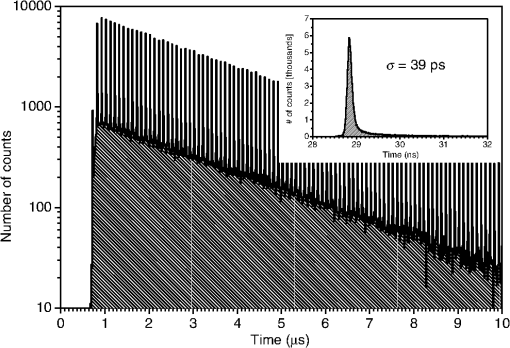 The SPAD is gated synchronously with local time scale at a low repetition rate, 100 Hz in our case. One can see from Fig. 5 that the detection efficiency rising slowly after gate start (about 500 ns). But the timing precision of detection remains unaffected, even total superposition of all detection events give us temporal resolution of 39 ps. In this particular realization, the total number of detection events was 305,000 and the integral value of useful stops after data processing was 162,000. It corresponds with data yield 53%. This value is strongly dependent on background noise, but it is demonstrating the possibility to achieve reasonable data yields on the pure single photon level (the signal strength was below ) while maintaining picosecond temporal resolution. 5.Summary and DiscussionWe have developed and tested a photon counting detector optimized for laser time transfer with picosecond precision and accuracy. The detector is extremely rugged and compact. The long-term detection delay stability in the sense of time deviation is excellent—typically 200 fs for averaging times of hours. The change of the detection delay with temperature is typically below . The newly developed detector’s operational scheme enables us to operate the detector in a gated mode and to achieve very high useful data yields exceeding 50% while still maintaining pure single photon operation and wide dynamical range. AcknowledgmentsThis research has been supported by numerous grants provided by the University, the Grant Agency of the Czech Republic, Ministry of Education of the Czech Republic, and international grant agencies, as well. The recent publication has been supported by grants RVO68407700 and SGS13/220/OHK4/3T/14. We are also acknowledging project DFG FOR1503. ReferencesJ. Levine,
“A review of time and frequency transfer methods,”
Metrologia, 45
(6), S162
–S174
(2008). http://dx.doi.org/10.1088/0026-1394/45/6/S22 MTRGAU 0026-1394 Google Scholar
I. ProchazkaJ. KodetP. Panek,
“Note: electronic circuit for two-way time transfer via a single coaxial cable with picosecond accuracy and precision,”
Rev. Sci. Instrum., 83
(11), 116104
(2012). http://dx.doi.org/10.1063/1.4766335 RSINAK 0034-6748 Google Scholar
P. PanekJ. KodetI. Prochazka,
“Accuracy of two-way time transfer via a single coaxial cable,”
Metrologia, 50
(1), 60
–65
(2013). http://dx.doi.org/10.1088/0026-1394/50/1/60 MTRGAU 0026-1394 Google Scholar
E. Samainet al.,
“Time transfer by laser link—T2L2: current status and future experiments,”
in Proc. FCS IEEE,
378
–383
(2011). Google Scholar
I. ProchazkaF. M. Yang,
“Photon counting module for laser time transfer via Earth orbiting satellite,”
J. Mod. Opt., 56
(2–3), 253
–260
(2009). http://dx.doi.org/10.1080/09500340802155396 JMOPEW 0950-0340 Google Scholar
I. Prochazkaet al.,
“Photon counting timing uniformity-unique feature of the silicon avalanche photodiodes K14,”
J. Mod. Opt., 54
(2–3), 141
–149
(2007). http://dx.doi.org/10.1080/09500340600791814 JMOPEW 0950-0340 Google Scholar
P. PanekI. Prochazka,
“Time interval measurement device based on surface acoustic wave filter excitation providing one picosecond precision and stability,”
Rev. Sci. Instrum., 78
(9), 094701
(2007). http://dx.doi.org/10.1063/1.2779217 RSINAK 0034-6748 Google Scholar
P. PanekI. ProchazkaJ. Kodet,
“Time measurement device with four femtosecond stability,”
Metrologia, 47
(5), L13
–L16
(2010). http://dx.doi.org/10.1088/0026-1394/47/5/L01 MTRGAU 0026-1394 Google Scholar
W. J. Riley, Handbook of Frequency Stability Analysis, NIST Special Publication 1065US Department of Commerce, National Institute of Standards and Technology, Boulder, CO
(2008). Google Scholar
BiographyJosef Blazej is an assistant professor at the Czech Technical University in Prague, Faculty of Nuclear Sciences and Physical Engineering, Department of Physical Electronics. He received his PhD degree in 2000. His fields of interest are picosecond lasers, detectors, and electronics. His present research comprises time-correlated photon counting using solid-state photon counters and its application in laser ranging, picosecond laser time transfer, quantum informatics, and optical time domain reflectometry. He is a member of SPIE. Ivan Prochazka is a professor of applied physics at the Czech Technical University in Prague, Faculty of Nuclear Sciences and Physical Engineering, Department of Physical Electronics since 2003. His research is focused on satellite laser ranging, single photon detection, picosecond timing, and photon counters. Jan Kodet is a researcher at the Czech Technical University in Prague. He received his PhD degree in 2012. He is now also working at the geodetical and laser ranging observatory Wettzell, Germany, to develop his experience with time transfer techniques, applications of photon counting, laser ranging, and picosecond timing hardware. |


